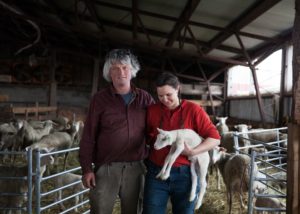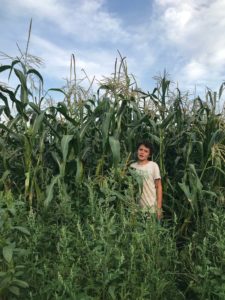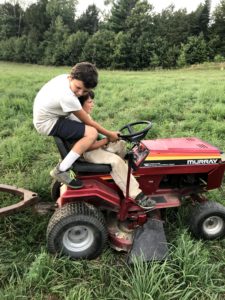PFAs in Maine
This page was last updated: July 9, 2024. We will update this page as soon as we have information to share. Please connect with us on Instagram @mistybrookfarmme and FaceBook @Misty Brook Farm.
PFAs Update June 2024
Dear Friends,
It’s already June! I can’t believe how fast the seasons and years go by! In this picture Alister is driving the tractor, Brendan and John are riding the planter for added weight and William is supervising. They get so big so fast! Alister is experimenting with a side by side of corn planted in plowed ground and corn no-tilled into a rye cover crop that the cows grazed and trampled. I’ll be interested to see the results!

Over the last year we have transitioned a lot of our fields with PFAS levels from hay production to grain production. We have wheat, barley, oats, and corn planted on the fields that were spread with sludge many years ago. We will continue to work with the state to test the grains we grow on these fields to make sure they aren’t picking anything up. We tested dry beans that were grown on fields with detectable PFAS levels (10.9ppb PFOS) and they came back non-detect, so that’s exciting!
We continue to work with the challenge of PFAS on our farm. While we are making progress we’ve had some setbacks. This winter we didn’t have the extra cows that we were milking last winter and when it was time to dry off a bunch of the herd we ran short on milk. The only feed that was high quality enough to keep production up was also from fields with some PFAS levels in the soil. Brendan mixed the bales with bales from non-detect fields, but the cows really favored the good feed from the bad fields and our February 22nd test results came back at 93.5ppt PFOS. That’s the highest result we’ve had in over a year and as soon as we got the result we changed the feed. Unfortunately the feed from clean fields that we switched the cows onto produced an off blueberry flavor in the milk, so we did our best to find a combination of feeds that didn’t flavor the milk and didn’t increase PFOS levels. (Brendan has every bale from every field marked with different colored tape, so he knows exactly where it came from.) This combination of feed didn’t help milk production, so we were short on milk until we were well into our calving season in April. Now the cows are completely on pasture and the PFOS levels are down again. Our last results from May 20th were 33.3ppt PFOS and the state is using a new lab (Maine Laboratories) that gets results back to us faster!
Our goal is still non-detect and it’s frustrating when you think you have a plan that works and conditions change. Brendan fed the same ratio of feed from the same fields the year before, but we’d had a dryer year, so now we wonder if the soil moisture at the time of hay harvest has something to do with the amount of PFAS compounds in the feed. Last fall and this spring we transitioned many of these fields to grain growing and they won’t be harvested for dairy feed this year. We’re also able to harvest some new seedings on clean fields now, so we are optimistic that we’ll be able to make more milk on clean feed this coming winter. For now the cows are grazing our clean fields and the PFOS levels in the milk should continue to drop. A trend we have noticed is that when the cows make less milk the butterfat, protein, and PFOS levels increase. When they make more milk the levels drop because the milk is more diluted, so seasonal changes will effect the levels as well as the feed the cows are eating. It’s all a work in progress with a lot of learning along the way.
Here are the ladies trying to convince me to move the fence for them, they have no idea what troubles we go through to make sure they have the best options for supper.
We have some other changes on the farm. Becca is taking over the sheep milking and she will be selling both raw sheep’s milk and sheep’s milk yogurt under her own label this summer. I’m excited to see her take what I started with the milking flock and make it even better! She’s hand picking the ewes that will work best for her and has set up a sweet milking parlor in our old vegetable pack shed, so we’ll still have the diversity of sheep grazing with the cows!
Some new additions to the farm are the brood mares and foals. I started out as a horse person before I was converted to a cow person, so I’m squeezing in a little horse time now. We’re able to utilize some of the high quality hay that the cow’s can’t eat because it would be too high in PFAS for the mares and boy did they grow some nice babies! They are pictured here at two (red/sorrel) and four (buckskin) weeks old. Both foals are colts, will be registered with the American Quarter Horse Association (AQHA), and are looking to be someones new best friend.
Pigs are pasturing on the neighbor’s fields again and will be adding much needed fertility. The laying hens have joined them on the field rehab team. These fields tested Non-detect for all PFAS compounds and just need some livestock to get things cycling again.
There are many steps along the road and sometimes we take a step backwards to regain our balance, but we won’t loose sight of the goal.
Our goal is to prove that when you care enough about LIFE, soil, plants, animals, and people; you can overcome anything and there IS a way FORWARD for repairing our soils and feeding our PEOPLE.
Your support makes it possible for us to take steps every day towards a healthier happier environment for soil, plants, animals, and people. We appreciate everyone who has stuck with us through it all and everyone who makes it possible for life to continue!
As always, I am happy to answer any and all questions.
Thank you for joining me on the journey! -Katia
PFAs Update April 2023
We really feel like we have come out the other side now! Spring brings so many new beginnings! We have a good crop of piglets started and more on the way. We are well into calving and lambing is almost done! The calling back and forth of ewes and lambs is the sound of spring to me. This warm weather and April showers have got all the pastures greening up. The laying hens made the great chicken migration out to their campers on pasture last weekend. We have been fixing all the fences in preparation for everyone else getting out to pasture soon too!
What a difference from last year. We are able to send everyone onto pasture with confidence that we aren’t exposing them to PFAS. We have come a long way over the last year. We now have consistently low test results on our milk with the combined herd and even with cows calving back in after their dry period we don’t see any increased levels. DACF has been doing a study on our heifers collecting matching milk and blood samples to test for PFAS. As expected the levels seem to drop pretty quickly a few days after calving and some tests are even coming back non-detect from these heifers. This information is a great relief as it confirms that the work we are doing to make sure our cows and heifers are eating clean feed is working. We continue to work towards our goal of non-detect on all test results.
We are planning to have sheep milk again this year! The state has sent out a bunch of preliminary milk samples for PFAS testing and we are hoping to get results soon. We made sure we fed the ewes all hay from non-detect soils for the last 6 months, so in theory we should be good to go. Tomorrow, Saturday morning we plan to run the sheep through the milking parlor to get them back in the routine. It will be the test run of the year! Right now the lambs are using most of the milk, so we don’t expect to get much, but it will help us make sure everything is working and ready for when the lambs get weened and we really get into production.
Pigs are all cleared and will be pasturing on a neighbor’s fields that need the fertility and soil life activation that pigs bring. These fields tested Non-detect for all PFAS compounds. We don’t need to test all the pigs anymore because we are confident that we are not exposing them to PFAS. The state will continue to monitor our pigs by taking samples from a pig out of each group of litters that we raise.
The laying hens never got exposed to PFAS and are on non-detect pastures out behind our barns. The cows will be grazing around the hens as they move across the pasture scratching for bugs and providing calcium rich fertility.
Exciting news: The state is funding investments in grain growing equipment and infrastructure so that we can utilize the fields that have levels of PFAS in the soil. PFAS are taken up by the leafy parts of the plant and don’t collect in the grain seed. So we will be using the fields with levels of PFAS to produce grains that will be milled into feed for our pigs. We now have a new to us (used, but well maintained) no-till grain drill that will make it more efficient for us to plant as well as making it possible for us to build a healthier soil by disturbing it less. We will be able to plant cover crops right into harvested grain stubble and keep the soil life happy with growing plants and cover. We have three grain bins on order that will be put up this year to dry and store the grain harvest and we have a grinder mixer on order that we’ll use to grind and mix the grain for our pigs. We are excited to be able to use all of our fields in a way the strengthens our feed supply for our livestock and appreciate the support from the Department of Agriculture, Conservation, and Forestry (DACF).
This all ties into our GOAL: Our goal is to prove that when you care enough about LIFE, soil, plants, animals, and people; you can overcome anything and there IS a way FORWARD for repairing our soils and feeding our PEOPLE.
Your support makes it possible for us to take steps every day towards a healthier happier environment for soil, plants, animals, and people. We appreciate everyone who has stuck with us through it all and everyone who makes it possible for life to continue!
As always, I am happy to answer any and all questions. Best, Katia.
Looking for more details? Keep reading…
PFAS Milk Test Data
Here are a couple graphs to show you how far we have come:

Below is a detail of the last three months so that you can see the numbers more clearly.

In this second graph you can see a little bump up in the beginning of February. We were feeding through an old pile of bales that the state had tested from 2021 and the results were non-detect. We think there was an un-marked bale that got fed by accident from the farm that caused our initial PFOS contamination. Brendan recognized the grass species in the bale when it was already in the feed bunk and partially consumed by the cows. Brendan thinks that one bale came from a field that tested 50ppb for PFOS in the soil. It was an un-marked bale and he only recognized it by knowing what plants grow in what fields. Our dairy herd goes through 3-4 big round bales of hay per day. This shows you how sensitive the milk test results are to what the cows are eating and what a small amount of lightly contaminated feed can do. We needed to feed all the hay we have to support our now larger herd, but thankfully we are finished with the old feed and everything we are feeding now has been well marked and we know exactly what fields it came from.
Conclusion: We have made huge steps in the right direction! We still have more work to do, but we know the direction we are heading in. Together we can make a difference, together we can create constant improvement!
PFAs Update February 2023
Looking back on a year filled with challenges and gratitude.
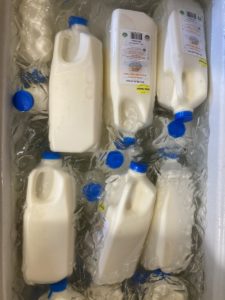
It has been a year since we discovered that our milk was contaminated with PFAs. The days that followed were full of tremendous uncertainty and fear. We had a hundred questions for every answer that was available, and suddenly the future health of our farm was uncertain. But over time, with tremendous support from our community and a *ton* of testing, we have come out on the other side feeling optimistic and strong.
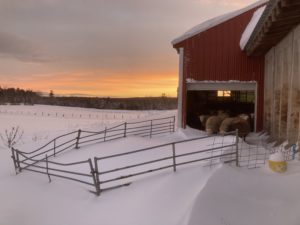
Katia continues to dedicate time to the the Maine PFAs Fund Advisory Committee (more information and links to past meetings here) and the fedeal government recently allotted $19 million to Maine communities to address PFAs contamination in drinking water. While we have been sending all of our test samples out of state, Maine now has a lab that can test for PFAs.
Our most recent milk test show a continued promising outlook. On December 30th, we combined our old and new herds (see the update from December 2022 below for more on this!), so the green line becomes the combined milking herd. Where there is a number 25ppt (parts per trillion), the tests results were non-detect. Anything under 25ppt is considered non-detect because the lab can’t accurately quantify levels below that!

The graph below shows a more detailed snapshot. You’ll see that the tests tend to fluctuate. The variability of results is partially due to variability in testing. We have also found that milk production effects the results. When we feed higher quality hay, the milk production goes up and the PFOS level goes down. When the cows have poorer quality feed, milk production goes down and the PFOS level goes up. We’ll see how this plays out over the remainder of winter. Some of the feed we bought came from fields that tested non-detect, but the feed quality isn’t as high as the feed we make ourselves. Can you tell this is a lot of trial and error? But we are making these decisions based on the a year of fighting for this farm, plus tremendous support and input from our state partners.
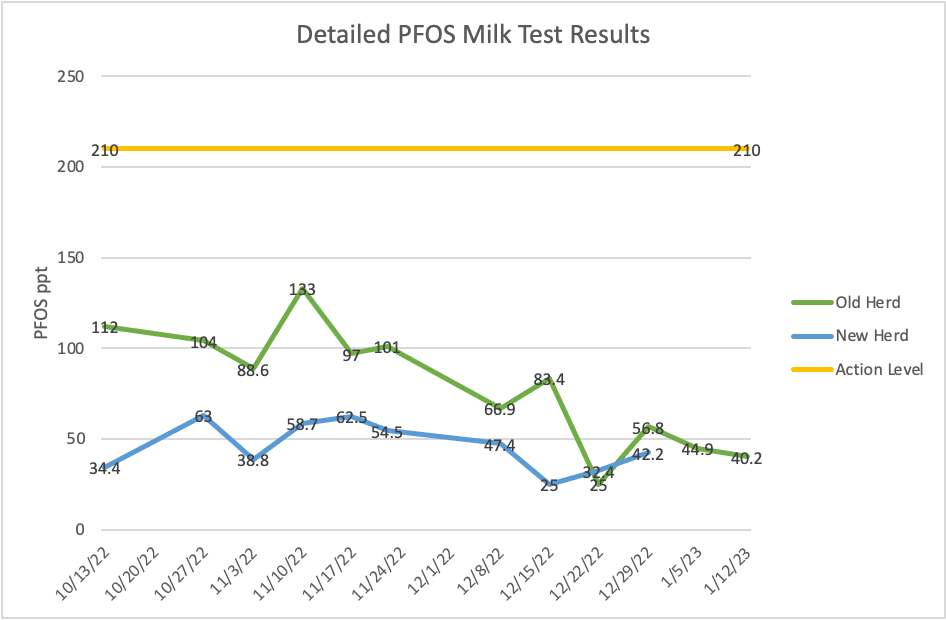
Besides more promising test results, we have the upcoming spring to prepare for and celebrate! In a couple of weeks, we will welcome friends and families in our community to our annual Sheep Shearing Day! We hope that you bring your families to the farm to learn about this traditional craft from the very talented Jeff at Buckwheat Blossom Farm. Save the date for Sunday, March 12th – the fun starts at 10am! And we will have newborn piglets to admire 🙂
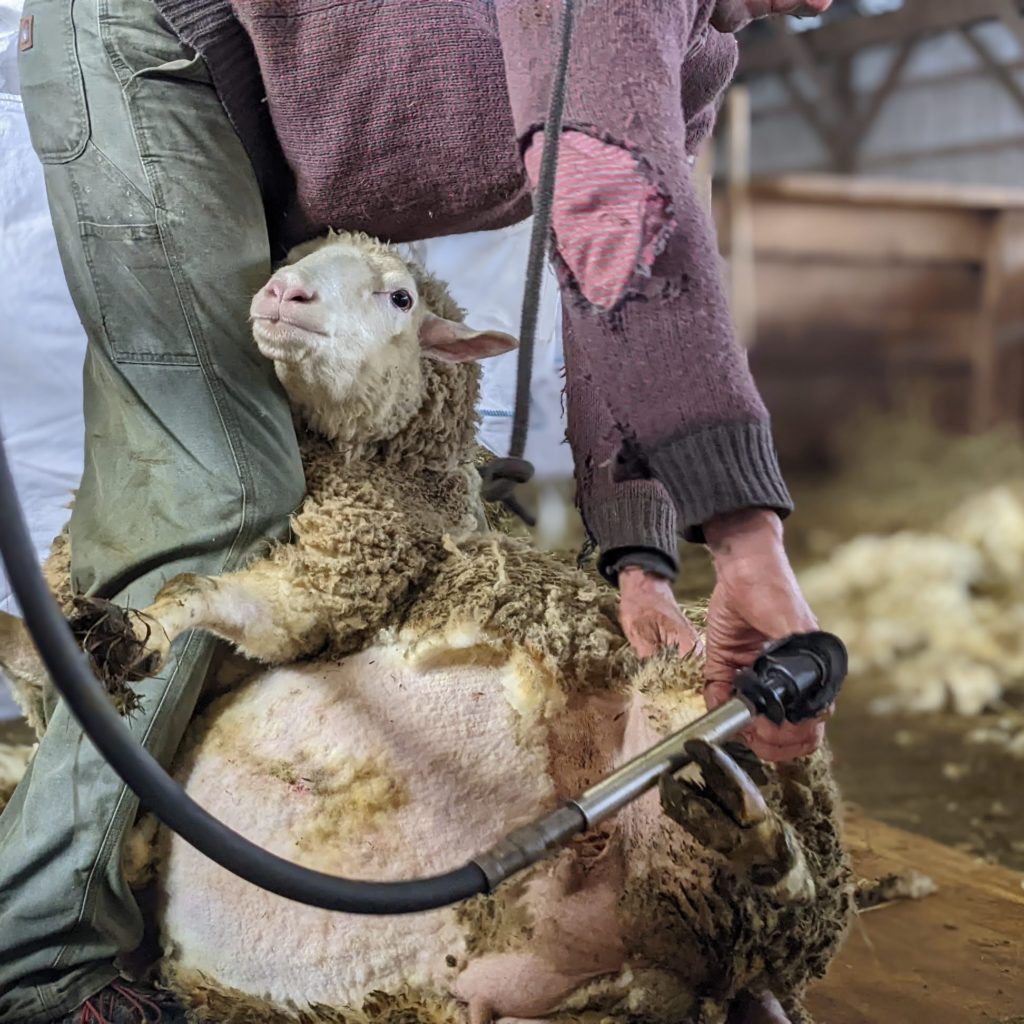
See you at the farm! 156 Bog Road, Albion, Maine
PFAs Update December 2022
The journey continues… With good news and a milestone met!
This has been a year to top all that came before, so many challenges! Our year started with the discovery of PFAS contamination in our dairy herd from bought in organic hay. Extensive testing uncovered more challenges; we have about 76 acres of fields with levels of PFAS contamination that need to be cropped differently, pigs need to be pastured on non-detect soils because they root in the soil, dairy cows are more sensitive to PFAS than the feed tests, non-detect hay can produce detectable levels of PFAS in the milk, thus soil tests are the way to go. So, we continue soil testing everywhere, including all the fields on all the farms we source hay from. And now we are losing 30 acres of non-detect fields we rent to solar panels…
Through all of this, chores continue. Every day we milk both herds of cows. We bottle milk from the new herd and dump the milk from the old girls that are contaminated with PFOS. Drought in July and August left us feeding lots of winter feed and another challenge, sourcing more PFAS free hay, making our best guess while waiting for more soil test results. Labs are backed up with some results taking two months to come back, five weeks seems like a quick turnaround now. Pigs were ready for slaughter, but then more waiting for test results. The pigs keep eating, we keep waiting…
How do we carry on with so many challenges? We have a GOAL.
Our goal is to prove that when you care enough about LIFE, soil, plants, animals, and people, you can overcome anything and there IS a way FORWARD for repairing our soils and feeding our PEOPLE.
We wouldn’t be accomplishing our goal without our hard-working team and amazing support from our community.
- Northern Tilth helped us with our initial PFAS testing.
- Maine Farmland Trust and MOFGA gave us immediate financial support when we discovered the contamination and stopped selling everything in February.
- The Department of Agriculture, Conservation, and Forestry (DACF) have supported us with PFAS testing and additional financial support.
- Herring Brothers has helped us work with the state to test animals at slaughter.
- Maine Center for Disease Control has helped us with number crunching, studying results, and providing suggested action levels that are a starting point and more than other states have.
So much good work is being done and we have received so much support through this challenging year! We thank everyone who has and continues to support us on this journey!
As we come to the end of this year, we reflect on what we have learned and how far we have come. We also look to the future and how much farther we must go! The graph below shows our progress with the original herd of cows. The old herd is in green, and the new herd is in blue. The yellow line indicates the state’s limit of 210. Please understand that we are still dealing with lag time on test results, so we are only able to show results from 5+ weeks ago. Our original cows have been below the state action level of 210 since the middle of August and the numbers have stabilized now that we are finished calving in the old herd for the season.
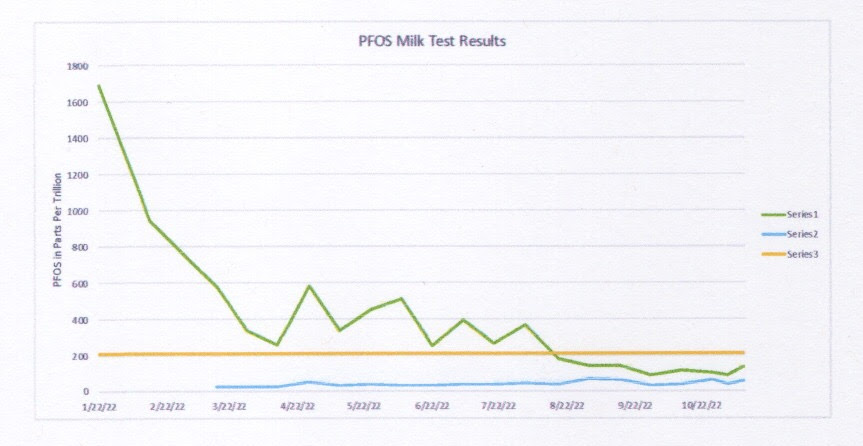 WE’RE ALMOST READY TO COMBINE OUR TWO DAIRY HERDS
WE’RE ALMOST READY TO COMBINE OUR TWO DAIRY HERDS
Our next step is to combine our old and new herds. This week we are doing a standard milk quality test (not a PFAs test) and once approved, we can combine the herds this weekend. We are able to do this safely because we have worked tirelessly to bring the contamination levels in the original herd to levels far below the state’s limits. When we first found out our herd was contaminated, many people asked or assumed that we would cull this herd. It would be expensive and require a lot of energy to continue milking, feeding, moving and caring for a herd of dairy cows that wasn’t making us a cent. But we never once considered this. With the support of our community, and the tireless efforts of all our family and staff, we are so proud to reach this point: Our old dairy herd is ready to be combined with the new girls, and we will have an abundance of milk once again!
The rough calculations suggest that the PFOS level in our milk would be between 50ppt and 80ppt if the two herds were combined. The state’s action level is 210ppt. We have been producing milk below this level from our old herd for 4 months now. Our goal continues to be non-detect for PFAS in our food and we are making the adjustments on our farm to get there, but Rome wasn’t built in a day and we are working with the feed and cows that we have this year. These girls are good healthy cows producing high butterfat and protein filled milk that we are still dumping every day.Our family is consuming all the foods we offer our customers. We have weighed the pros and cons and feel comfortable with the combination of the two herds.
 Bounty, Jill, Barley, and their friends patiently waiting to join the other girls in the dairy barn.
Bounty, Jill, Barley, and their friends patiently waiting to join the other girls in the dairy barn.
Looking for more details? Keep reading…
INITIAL PFOS CONTAMINATION
In January of this year, we decided to test our cow’s milk for PFAS compounds. This decision was made when we heard there were other farms in our area effected by PFAS and we wanted to make sure we were providing our customers with healthy foods. (PFAS testing of food is currently not required.) We received our test results three weeks later and the cow’s milk tested at 1690ppt PFOS. We knew this was a short-term contamination issue because the state had tested our milk earlier in 2021 and the results were below 25ppt. We had taken a feed sample the same day as the milk sample and were able to determine that the hay we had been feeding the cows in late 2021 and January of 2022 was the source of the contamination. The hay came from newly transitioned corn fields on a nearby farm. The hay tested at 45-55ppb for PFOS and came from fields that tested about 200ppb in the soil for PFOS. We fed about 50 round bales of this hay to our dairy herd, nurse cows, and dairy ewes. An additional 312 bales that we had on hand from these fields was eventually hauled to a land fill to be used as padding at the bottom of a new cell. DACF funded the purchase of 316 bales of hay that tested non-detect to replace the highly contaminated hay. We are lucky we tested the milk when we did and that we hadn’t fed most of the contaminated hay yet.
EXTENSIVE (& expensive!) TESTING AND MORE FINDINGS
When we found the contamination in our cow’s milk, we didn’t know if we had spread the contamination further by feeding skim milk to our pigs and calves, so we started testing everything. We found out that the milk didn’t have a high enough transfer factor to affect the pigs that drank some milk but were raised on hay and grain over the winter. These pigs tested non-detect in the meat. But the pigs that had been pastured on soil with levels of about 9ppb PFOS had detectable levels in the meat, so we stopped pasturing pigs on soils with PFAS compounds. All of the contaminated meat from these pigs was sent to the landfill. We put our spring piglets on the 22 acres of land we cleared for pasture on our Unity property because we had cleared 80-100 year timber growth in 2016 and there was no chance of contamination from previous farming practices. We will use a different field with non-detect soil to pasture the pigs in 2023.
Normally we use our pigs to fertilize the field we plan to grow winter wheat on, but now we must change the way we rotate our animals and crops. The grain portion of the plant doesn’t readily take up the PFAS compounds, so grains can be grown on fields with PFAS levels in the soil. Pigs cannot. The sows that were pastured on contaminated soil passed some of the PFAS compounds to their piglets, but once those piglets grew up on the cleared field in Unity they tested non-detect in the meat for PFAS. We are now breeding some of the pigs pastured in Unity for spring 2023 piglets and feel that we have a good understanding of how to keep our pigs safe from future contamination sources.
The calves that were fed contaminated milk have grown a lot and are now over a year old. On December 8th we took blood samples from many of them as well as many of our new younger calves. We hope to estimate from the blood results what we can expect in the meat, and this will help us determine how long we need to keep them to allow the PFAS to leave their bodies. In June, we depopulated and tested a few cows and some sheep. The cows had eaten the highly contaminated feed and tested from non-detect to 2.2ppb PFOS in the meat. A significant drop from the herd bull slaughtered in December 2021 who tested 4.46ppb and a nurse cow slaughtered in January that tested 10.6ppb for PFOS. (Again, all the contaminated meat was sent to the landfill along with meat we weren’t able to test, that may or may not have been contaminated.) We also tested the calves that were growing inside the depopulated cows, and both tested non-detect in the meat. So, it was good to know that our calves are probably starting out on a good hoof, and we are hopeful this blood testing of the young calves we have now will confirm that they will be good for future meat and milk production.
The ewes that ate the highly contaminated hay had levels ranging from non-detect to 0.95 PFOS in the meat. The lambs born this spring that were nursing the ewes tested non-detect in the meat. With this information we feel confident that we can keep our flock and produce sheep milk again in 2023.
Our chicken eggs tested non-detect and the stew hens we had in the freezer also tested non-detect. We have been careful to pasture our hens on only non-detect soils because they eat bugs and worms that live in the soil.
SOIL TEST RESULTS
When we discovered hay with non-detect results can produce milk with levels of PFAS, we worked closely with DACF to get all our soils tested. We chose to test fields based on the way they were historically farmed in the hopes we could isolate areas that had different application rates in the past. This was somewhat successful. We were lucky that even though the pastures by the barn had been licensed for spreading, they had not been spread and tested non-detect for the most part with a couple pastures testing 0.369ppb and 0.379ppb for PFOS. At this time DACF recommends that soils with levels over 6.8ppb PFOS not be used for pasture based dairy production.
- On our property we have 159 acres of fields and pasture that tested 0.4ppb PFOS to non-detect in the soil.
- We have 39 acres of fields that tested 2.53ppb to 6.75ppb PFOS in the soil.
- And we have 76 acres of fields that tested 6.96ppb to 14.3ppb PFOS in the soil.
- In addition, we rent about 284 acres of fields with soils that tested below 1ppb PFOS and about 48 acres of fields with soils testing from 1ppb to 4.6ppb PFOS.
We are lucky for the clean land we have, and we are also lucky that we have the challenge of learning how best to use the land that is contaminated with PFOS. Remember our goal is to heal the soil and provide people with healthy food. As people living on this earth now, we must take responsibility for the mistakes made in our history and provide solutions for the future.
The unfortunate fields that have levels of 200+ppb PFOS in the soil may not be usable for food in our lifetime, but the levels of PFOS that are in our farm’s soils are workable and we will not give up on the fields that are in our care. Brendan loves his fields with a passion that would break his heart if we were to give up on any of these fields. We have already come so far bringing the soils to life. Every soil test pit has earthworms now and it is a challenge to keep up with feeding them all by putting plant litter on the soil surface for them to incorporate in the soil and built organic matter.
MILK TEST RESULTS
Below is a graph showing a detail of the August to November milk test results from both herds. You can see that we have some low levels of PFOS in the new herd. We believe this is from hay we fed both on pasture and in the barn. In the end of October and November we fed the rest of the bales that tested non-detect, but came from unknown field soil levels. Everything is a work in progress, and we are still learning. It is going to take us a few years to shift our fields with PFOS levels into different production and at this point in time we need to work with the hay that we have to feed our cows. As an old friend likes to say, “Cows can’t live on snowballs”. We have been building relationships with other farmers who have fields with non-detect soil and plan to source as much hay from them as possible. Our goal is to get all of the cows to produce non-detect milk. We have come a long way this year, but as you can see, we have more work to do. We are tracking everything we feed this winter along with what field it came from, and the milk is being tested every week, so we will know a lot more as we enter the 2023 growing season.

CONCLUSION
We didn’t even know what PFAS were in the beginning of 2021. Now we know many of the PFAS compounds personally. We have learned so much in 2022 and I hope that if you are still reading this, you also have a passion for learning and improving.
Together we can make a difference, and together we can face the challenges that lie ahead.
PFAs Update October 2022
Both the sheep and the old herd made it below the states action level of 210 parts per trillion, yay! They are heading in the right direction. Check out the graph below. We are going to be drying off the ewes now and it looks like we will be able to sell bottled sheep’s milk again in 2023.
 We were worried about the pigs we have been raising all summer because their moms were exposed to the contaminated hay and manure from the cow barn during their gestation period (they are housed behind the cow barn in the winter), but the batch of porkers we just sent all tested non-detect. So, we have a lot of pork cuts coming in! Please fill out the interest form on our homepage for more information. Ham steaks, roast, chops, ground, sausage, bacon, smoked shoulder, hocks, and Alister is harvesting beans this week. Pork and beans are in our future!
Amanda Beal (Commissioner of Agriculture) asked Katia to be on the PFAS Fund Advisory Committee, so we will continue to be active in working to ensure progress is made in addressing PFAS contamination in our state. Katia is honored to be on the committee and hope to help the state of Maine address PFAS contamination in a proactive and comprehensive way as well as being a support to other farms facing PFAS contamination.
PFAs Update July 2022We wanted to share an update on our PFAs testing, since we are very much still on the bumpy path forward. The good news is that the PFAS crisis is being taken more seriously on a national level. Perhaps some of you have read the Washington Post article that relays the EPA’s new findings around PFOA and PFOS. The article states:
Understanding the actions levels for PFAsPut on your science lab coats and thinking hats… We are learning about PFAs at the same time you are (and the CDC, EPA, DACF… this is new to ALL of us!) Let’s start with some simple vocabulary and definitions…
The Maine CDC’s new calculations would change the action levels for:
So, 0.4 ppb is the same as 400 ppt. The new proposed milk action level of 44 ppt is only just above the accurately detectable level. Anything under 25 ppt is generally considered a non-detect in milk with the current testing abilities of the labs.
Maine DACF hasn’t changed their action levels on food yet. We think there is foot dragging on adopting these new action levels because there are many farms in the state that would not be able to meet the new levels and the state isn’t ready to deal with the bigger problem yet.
Where do these limits come from?These numbers are calculated based on the 95th percentile of people in the US. That means the CDC looks at the data that is collected through the most recent census on how much beef for example a person consumes in their diet. Then they look at the people who consume the most beef (95th percentile) and make their calculation for a safe limit for that group of people. So, what are we doing?
Progress in decreasing PFAs in our milk
As you can see from this graph it’s a bumpy road to decontaminate our cows and sheep. The old herd shown in green made steady progress when we took them off the contaminated hay. But in April you can see they went up again when a bunch of cows calved in after being dry for two months. They don’t shed the PFOS as fast when they aren’t making milk. In the end of May beginning of June they went up again when we dried off a bunch more cows that were lower, so now most of the old herd have calved in again or are dry and taking a break for the last two months of their pregnancy. The new herd in blue are pretty consistent. In the end of April you can see we fed the hay that tested non-detect in ppb, but clearly contained a little PFOS. The sheep flock in yellow lambed in April and you can see there was some variation as more ewes joined the flock. They seem to be making good progress now. Soil Testing90 acres of our farm has tested positive for PFAs. We have changed some of our cropping plans and let some of our best dairy quality forage fields go by with the plan to make bedding hay rather than risk feeding it to our cows. This is hard for us as we spent the last 9 years rebuilding the soil life and plant species in these fields to produce some of our best quality winter dairy feed. We are lucky that almost all of the fields around the barn are non-detect. So, the cows are grazing the non-detect fields without any risk of contamination.
How PFAs Stick Around (aka how they got to be called “forever chemicals”)
We need more studies to find trends that can give us a better understanding of how the PFAS chemicals move. We unfortunately discovered that non-detect hay tested in ppb can produce milk that show detectable levels in ppt. We thought we were safe to feed the bales that had been cut open and tested non-detect, so we fed them to both herds and the new cows tested 35 parts per trillion for PFOS in the milk. We changed what we were feeding the new cows as soon as we found out and they are now grazing on pastures that tested non-detect in the soil. It just shows how vigilant we need to be and how much more testing needs to be done to figure this all out. Right now we are keeping detailed records and marking all of the bales we make so that we can decide what to feed and what not to feed the cows when we know more. It is challenging to be the people figuring all of this out, but we need to know and the only way to find out is to ask questions, look for answers, and test.
Looking forward for our familyWe eat the foods we produce every day. We stand by its quality and the health it brings all of us. We believe that the benefits of eating organic, grassfed and pastured meat outweigh the minimal detection of PFAs in the products we are eating and selling. We want to live in a community where we can trust the food we grow and our neighbors grow. We continue to face the PFAS challenge and with your support we will find the best way forward. We all care deeply about providing people with healthy foods now and for generations to come. The Holmes family tested for PFAS in their blood, too.The 95th percentile of people in the US have 3.8 ppt PFOA and 15 ppt PFOS in their blood.
Our hearts go out to people with such high levels; we feel we are lucky. We ate the meats that tested over 3.4ppb PFOS and we drank the milk that tested 1690ppt PFOS before we knew it was there. Sometimes we find it hard to keep looking for something so small we can’t see it, smell it, taste it, or find any sign of it. We feel like we are up against the invisible enemy. As always, please reach out with any questions. We may not have the answers, but we are learning every day and we are working hard to be transparent and continue to grow healthy food for our family and yours.
|

